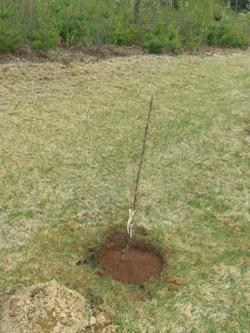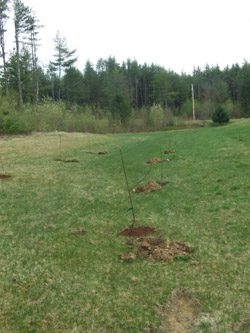How To Plant Apple Trees
Planting Apple Trees


Tree Placement
Before planting the apple trees it’s important to select a location that receives full sunlight throughout the day. It’s also important that you plant trees that require cross-pollination close enough to each other as required by the tree type (read more about it in the previous article about planting apple and peach trees).
Tree spacing depends on the type of root stock and therefore size of the mature tree. Our trees are EMLA 7 rootstock which means they will mature to a height of 12′ to 15′. Spacing should be roughly the same as the mature height. Therefore we planted our trees 15 feet apart.
Digging Holes
We purchased apple trees that have a trunk diameter of approximately 1/2 inch with a total height of about 3′ to 4′. According to Adams County Nursery (where we purchased our trees) the holes should be approximately 18 inches in diameter and 18 inches deep. It’s really important that you break up any hardpan layers or stiff clays to improve water drainage.
Planting Apple Trees


The tree should be placed into the hole so that the final backfill is located approximately 2 inches below the bud union. Use a good quality top soil and be sure it’s compacted around the roots so there are no voids.
Watering and Fertilizers
New trees must be watered on a regular basis. If nature doesn’t provide watering from rain then you should plan on watering the trees at least once a week for the entire growing season. The literature recommends 3 to 4 gallons for each tree.
New trees can be fertilized about one month after they are planted. ACN recommends 4 oz. of 10-10-10 fertilizer per tree around the base of the tree, being careful not to get it too close to the trunk.
Pruning
Transplanted trees must be pruned in order to promote good root growth before the tree expends energy on branches and leafs. Scaffold branches below 18 inches should be removed. The leader should be cut down to 18 inches above the top most scaffold branch. Finally all the scaffold branches should be cut back to a length of 12 inches.
Recent Posts
Framing Stick Nailer vs Coil Nailer
Which is Better a Stick Nailer or Coil Nailer? Framers have many choices in nailers…
How Many Roofing Nails Per Square of Shingles
Estimating How Many Nails for a New Roof When it comes to estimating materials for…
Composite / PVC Decking – Layout Tips & Advice
Composite / PVC Decking Layout Tips and Advice Composite and PVC decking have really changed…
Benefits of an ERV System (Energy Recovery Ventilator)
Benefits of ERV Systems (Energy Recovery Ventilator) If you're building a new home or doing…
Vermiculite Attic Insulation Abatement
Vermiculite Attic Insulation If your home was built before 1990 there is a chance it…
Nuisance Tripping of AFCI (Arc Fault) Circuit Breakers
Arc Fault (AFCI) Circuit Breakers Tripping Often An arc-fault circuit interrupter (AFCI) or arc-fault detection…